Eduardo Mendoza highlights the influence of Baroja, youth reading and comics in his writing
José Pizarro is the next guest of the Blanco-White dialogues at Instituto Cervantes London
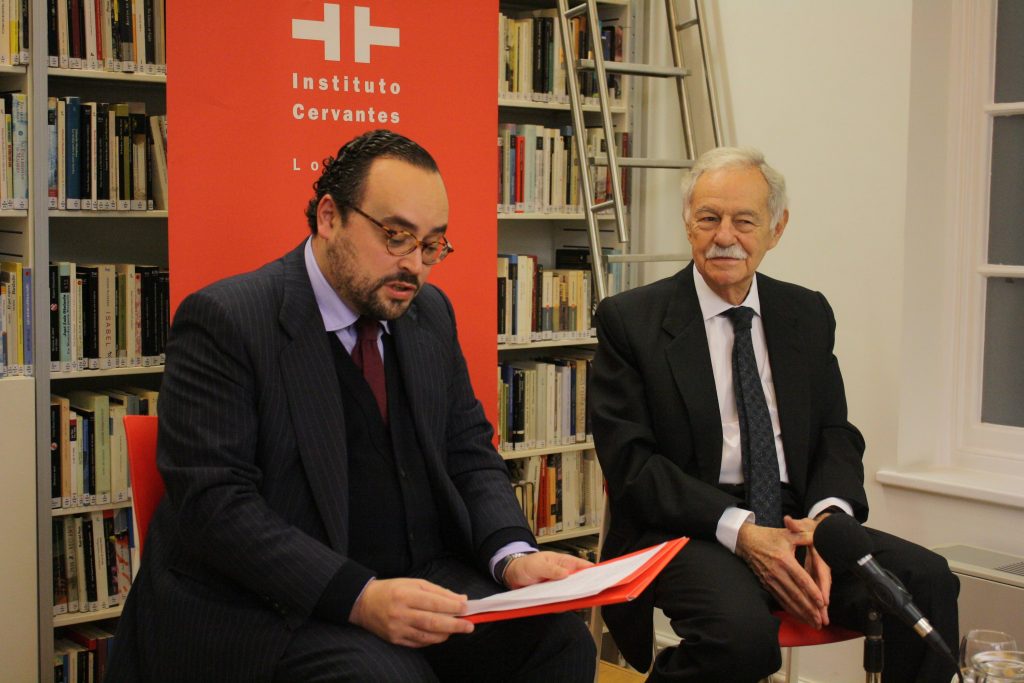
Spanish writer Eduardo Mendoza highlighted the influence of Baroja, youth reading and comics on his writing. Mendoza identified these influences during the second meeting of the Blanco-White Dialogues at the Instituto Cervantes London, in conversation with its director, Ignacio Peyró.
Peyró commented the library has “more books by Mendoza than the writer has in his own home”, highlighting that he is a “great writer with great readers.” Furthermore, Peyró praised the writer for being not only an extraordinary novelist but for managing to seduce critics throughout his 40-year career success.
Mendoza acknowledged that at Instituto Cervantes in London, he feels like at home. In addition to using its great library regularly, Mendoza was awarded the prestigious Cervantes Prize in 2017 at the London Centre, and the press conference was held at its facilities.
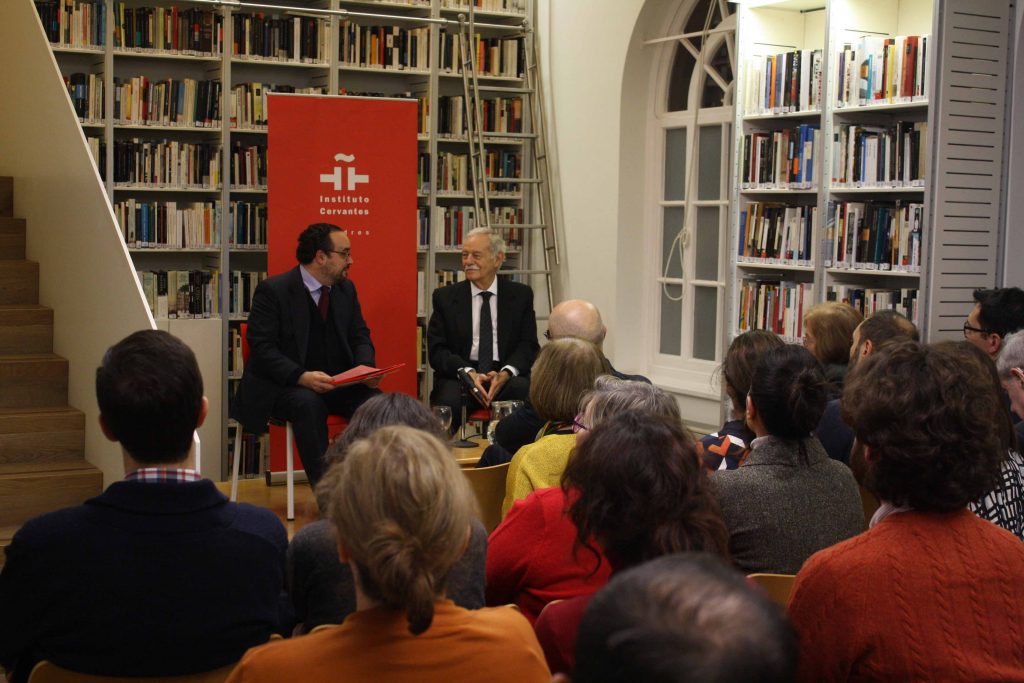
Inspiration from all the things you receive
The author, from Barcelona, pointed out that he is so attached to the act of writing that practically all stimulus from the world around him is immediately transformed involuntarily into literary material.
Mendoza pointed out the concerns common to all writers, including himself. He spoke of the nervousness of publishing your first book as a new writer and especially if it is an ambitious novel. He feels that writers all think the same way: “I like it so much, I can’t do it again, Now I can’t write anything anymore.” He believes, however, that in fact, the opposite is true. They’ve only just begun to be a writer, more things remain to be written.
“When I am finishing a book I start to get very nervous and I start to be in a hurry because I have already thought about the next book. On many occasions, what follows does not bear fruit but it is true that I have the impulse to continue writing. Sometimes I think I should stop, not because I feel like stopping, or because it would affect my physical and mental health, but instead it would affect readers and maybe my history. I still have not made a big mistake, small mistakes yes, I better retire now that I am at a suitable time with a race behind my back, but I will not do it,” Mendoza acknowledged.
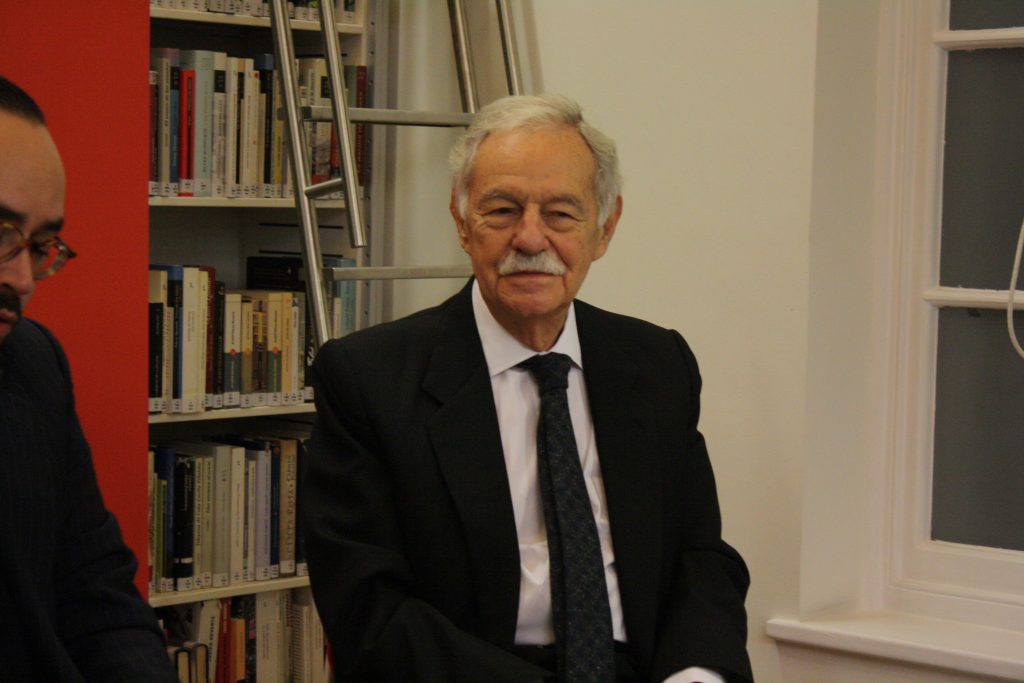
Writing from the cradle
The acclaimed author of Sin noticias de Gurb joked that he was writing something from the crib. From a very young age, he adored storytelling. He now recognises the cruelty of his passion on his parents, joking that he would force them to read him stories for hours and hours every day.
Mendoza recollects that he learned to read early. Whilst still in kindergarten as a young child, there was very little play or unstructured learning; instead, every day, they would sit and learn the alphabet.
Profitable and joyful reading were hard for him, which is why he asked his parents to read to him. Even as a child, he hoped that one day he himself would be able to write such beautiful stories. And so, he immediately began to write, never imagining that someone would read it, that it could be published or that he could become an author.
Youth Reading and Comics
Mendoza acknowledged that you learn to write simply by reading. When he first started, he embarked with enthusiasm but was mostly copying and imitating other works. There was a moment in which he discovered the influences of youth reading, with the novels of Stevenson or Walter Scott. He also found great inspiration in the great era of Spanish comics with characters that he defines as very close to him. Through these, he has lived and continues living, and with a very florid way of speaking, that replicated political and courteous rhetoric.
The author of La ciudad de los prodigios exalted among the great writers who dazzled him, naming specifically Franz Kafka, James Joyce, and then he found Pío Baroja. Baroja was the person who was at a fair distance from Mendoza, with a style that seemed “magnificent, being able to walk by his side and develop his own voice.”
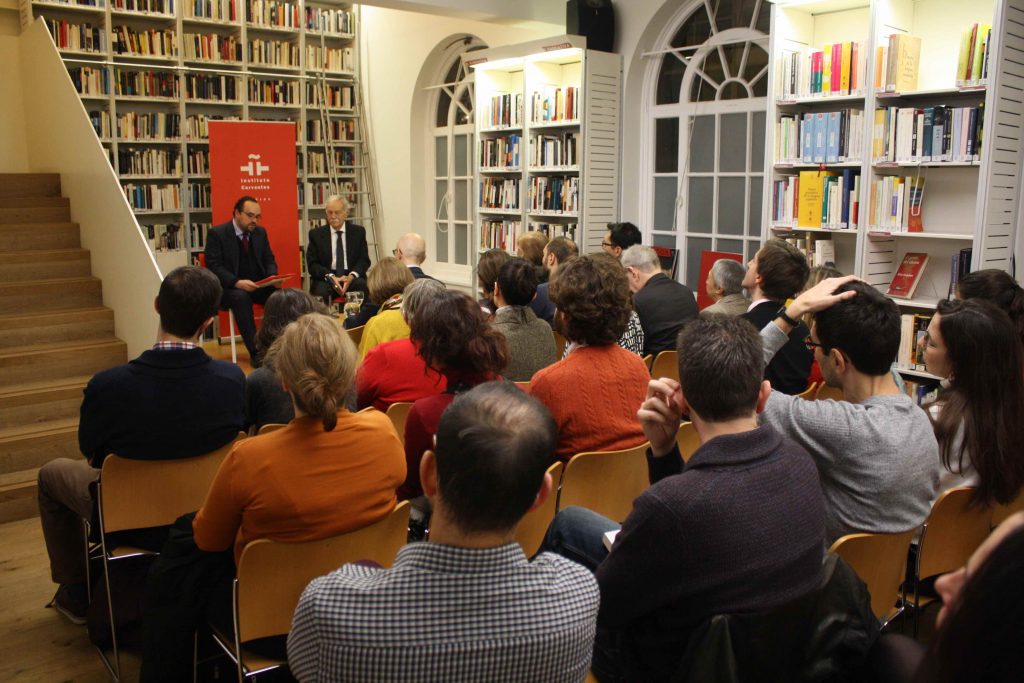
José Pizarro, next guest of the Blanco-White dialogues
The next guest of the Blanco-White Dialogues will be Spanish chef José Pizarro, in an event that will take place on Wednesday, January 22, 2020 at 7:00 p.m. Prior to Mendoza, the dialogues at Instituto Cervantes London had the pleasure of talking to an exceptional guest: the dancer and director of the English National Ballet, Tamara Rojo, on October 29th.
The Blanco-White Dialogues bring great figures of Spanish culture and relations between Britain and Spain to the British public. In a relaxed and relaxed environment, prone to confidences, the guests have an in-depth conversation and open to the public.
Eduardo Mendoza destaca la influencia de Baroja, la lectura juvenil y los tebeos en su escritura
José Pizarro, próximo invitado de los diálogos Blanco-White en el Instituto Cervantes de Londres

El escritor Eduardo Mendoza protagonizó el segundo encuentro de los Diálogos Blanco-White en español en el Instituto Cervantes de Londres, en una conversación con el director del centro, Ignacio Peyró, en la que ensalzó la influencia de Baroja, la lectura juvenil y los tebeos en su escritura.
Peyró explicó que la biblioteca del centro tiene “más libros suyos que Mendoza en su propia casa”, resaltando que es un “gran escritor con grandes lectores”, además de ser un extraordinario novelista que ha sabido seducir a la crítica a lo largo de una carrera de 40 años de éxitos.
Mendoza reconoció que en el Instituto Cervantes de Londres se siente como en casa. Usuario habitual de su biblioteca debido a su gran vínculo con Londres, además, en ella vivió un día muy especial de su carrera, cuando le otorgaron el prestigioso Premio Cervantes en 2017 y se celebró en sus instalaciones la rueda de prensa.

Inspiración de todas las cosas que recibe
El autor barcelonés apuntó que está tan hecho por la actividad de escribir que prácticamente todas las cosas que recibe a través de los ojos, los oídos y cualquier otra forma, inmediatamente las empieza a transformar involuntariamente en material literario. Así, dijo que “si no las llevara al papel, se me estropearía dentro como un pescado en mal estado”.
Mendoza apuntó a las preocupaciones que tienen los escritores, incluido el mismo, cuando acaban de escribir el primer libro y consiguen publicarlo, en especial si es una novela ambiciosa, y piensan, “esto que me gusta tanto ya no lo puedo volver a hacer, ahora ya no puedo escribir nada”. Sin embargo, cree que ahora es todo lo contrario, ya que es cuando más cosas quedan por escribir.
“Cuando estoy terminando un libro ya empiezo a ponerme muy nervioso y empiezo a tener mucha prisa porque ya se me ha ocurrido el siguiente. Muchas veces ese siguiente no fructifica pero es verdad que tengo el impulso de seguir escribiendo. A veces pienso que debería parar, no porque tenga ganas de parar, ni porque me afectaría a mi salud física y mental, pero en cambio le afectaría en bien a los lectores y quizás a mi historial. Todavía no he cometido un gran error, pequeños errores sí, más vale que me retire ahora que estoy en un momento adecuado con una carrera a la espalda, pero no lo pienso hacer”, reconoció Mendoza.

Escribiendo desde la cuna
El autor de la aclamada Sin noticias de Gurb bromeó diciendo que en la cuna ya estaba escribiendo algo. De muy pequeño le gustaba mucho que le contarán cuentos, reconociendo que fue bastante cruel con sus padres porque les obligaba a leerle durante mucho rato cada día.
Mendoza recuerda que aprendió a leer bastante pronto, ya que en aquel entonces estaba en un jardín de infancia, en el que lo primero que hacían era poner en la pizarra las letras del abecedario y era lo que hacían desde el primer día, sin nada de jugar o correr por el patio.
La lectura provechosa y gozosa le costaba y por ello le obligada a hacerlo a sus padres, pensando que algún día él mismo podría ser el que llegase a escribir historias tan bonitas como las que le leían. Enseguida empezó a hacerlo, pero sin pasársele por la cabeza que lo fuese a leer alguien, que aquello se pudiese publicar o que se pudiese convertir en un autor.
Lectura juvenil y tebeos
Mendoza reconoció que a escribir se aprende leyendo y lo que hacía cuando empezó con entusiasmo era copiar e imitar. Ahí fue el momento en el que descubrió las influencias de la lectura juvenil, con las novelas de Stevenson o de Walker Scott, además de la gran época de los tebeos españoles con unos personajes que definió como muy próximos, con los que ha vivido y sigue viviendo, y con una manera de hablar muy florida, que replicaban la retórica política y cortesana.
El autor de La ciudad de los prodigios ensalzó entre los grandes escritores que le deslumbraron a Frank Kafka y James Joyce, para luego encontrar a Pío Baroja, la persona que estaba a la distancia justa, con un estilo que le pareció “magnífico, pudiendo ponerse a su lado y desarrollar su propia voz”.

José Pizarro, próximo invitado de los diálogos Blanco-White
El próximo invitado de los Diálogos Blanco-White será el chef español José Pizarro, en un evento que tendrá lugar el miércoles 22 de enero de 2020 a las 19:00 horas. Anteriormente a Mendoza, los diálogos en el Instituto Cervantes de Londres contaron con una invitada de excepción, la bailarina y directora del English National Ballet, Tamara Rojo, el martes 29 de octubre.
Los Diálogos Blanco-White acercan al público británico a grandes personajes relacionados con la cultura española y las relaciones entre Gran Bretaña y España. En un ambiente distendido y relajado, propenso a las confidencias, los invitados mantienen una conversación en profundidad y abierta al público.
El Quixot i Tirant a Londres
Jordi Amat inaugura les Conferències Joanot Martorell a l’Institut Cervantes londinenc
- La Vanguardia
- 4 Dec 2019
- MAGÍ CAMPS
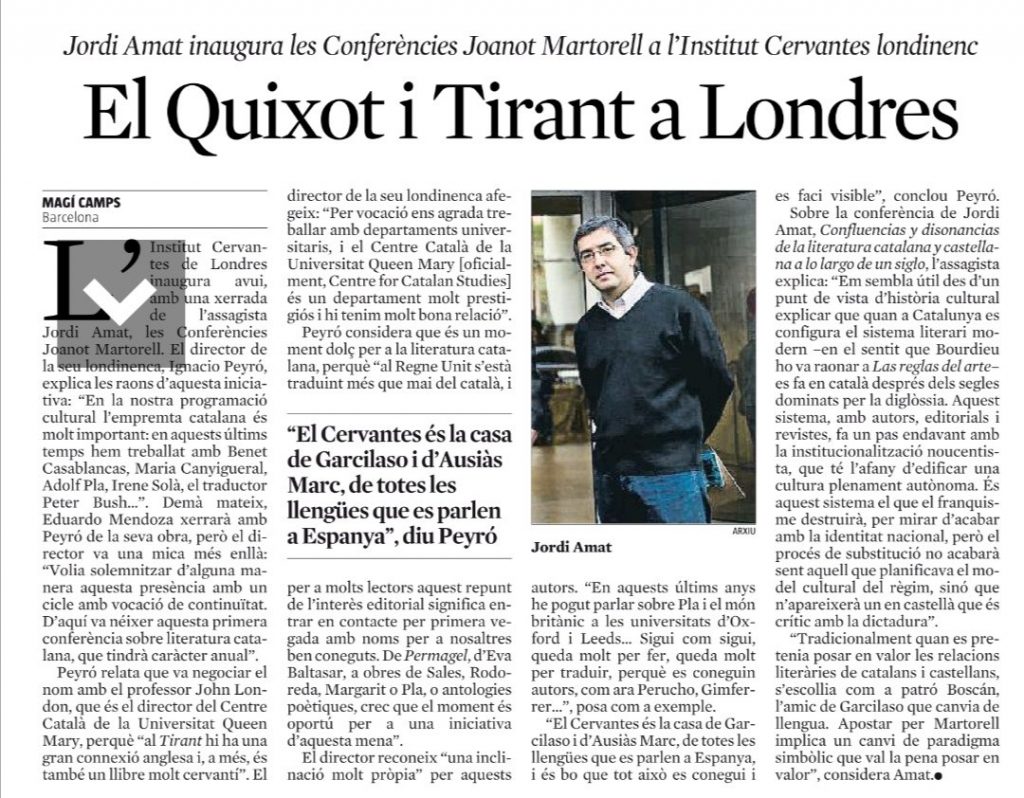
L’Institut Cervantes de Londres inaugura avui, amb una xerrada de l’assagista Jordi Amat, les Conferències Joanot Martorell. El director de la seu londinenca, Ignacio Peyró, explica les raons d’aquesta iniciativa: “En la nostra programació cultural l’empremta catalana és molt important: en aquests últims temps hem treballat amb Benet Casablancas, Maria Canyigueral, Adolf Pla, Irene Solà, el traductor Peter Bush…”. Demà mateix, Eduardo Mendoza xerrarà amb Peyró de la seva obra, però el director va una mica més enllà: “Volia solemnitzar d’alguna manera aquesta presència amb un cicle amb vocació de continuïtat. D’aquí va néixer aquesta primera conferència sobre literatura catalana, que tindrà caràcter anual”.
Peyró relata que va negociar el nom amb el professor John London, que és el director del Centre Català de la Universitat Queen Mary, perquè “al Tirant hi ha una gran connexió anglesa i, a més, és també un llibre molt cervantí”. El director de la seu londinenca afegeix: “Per vocació ens agrada treballar amb departaments universitaris, i el Centre Català de la Universitat Queen Mary [oficialment, Centre for Catalan Studies] és un departament molt prestigiós i hi tenim molt bona relació”.
Peyró considera que és un moment dolç per a la literatura catalana, perquè “al Regne Unit s’està traduint més que mai del català, i per a molts lectors aquest repunt de l’interès editorial significa entrar en contacte per primera vegada amb noms per a nosaltres ben coneguts. De Permagel, d’Eva Baltasar, a obres de Sales, Rodoreda, Margarit o Pla, o antologies poètiques, crec que el moment és oportú per a una iniciativa d’aquesta mena”.
El director reconeix “una inclinació molt pròpia” per aquests autors. “En aquests últims anys he pogut parlar sobre Pla i el món britànic a les universitats d’Oxford i Leeds… Sigui com sigui, queda molt per fer, queda molt per traduir, perquè es coneguin autors, com ara Perucho, Gimferrer…”, posa com a exemple.
“El Cervantes és la casa de Garcilaso i d’Ausiàs Marc, de totes les llengües que es parlen a Espanya, i és bo que tot això es conegui i es faci visible”, conclou Peyró.
Sobre la conferència de Jordi Amat, Confluencias y disonancias de la literatura catalana y castellana a lo largo de un siglo, l’assagista explica: “Em sembla útil des d’un punt de vista d’història cultural explicar que quan a Catalunya es configura el sistema literari modern –en el sentit que Bourdieu ho va raonar a Las reglas del arte– es fa en català després dels segles dominats per la diglòssia. Aquest sistema, amb autors, editorials i revistes, fa un pas endavant amb la institucionalització noucentista, que té l’afany d’edificar una cultura plenament autònoma. És aquest sistema el que el franquisme destruirà, per mirar d’acabar amb la identitat nacional, però el procés de substitució no acabarà sent aquell que planificava el model cultural del règim, sinó que n’apareixerà un en castellà que és crític amb la dictadura”.
“Tradicionalment quan es pretenia posar en valor les relacions literàries de catalans i castellans, s’escollia com a patró Boscán, l’amic de Garcilaso que canvia de llengua. Apostar per Martorell implica un canvi de paradigma simbòlic que val la pena posar en valor”, considera Amat.
Don Quijote y Tirant en Londres
Jordi Amat inaugura las Conferencias Joanot Martorell en el Instituto Cervantes londinense
- La Vanguardia
- 4 Dec 2019
- MAGÍ CAMPS
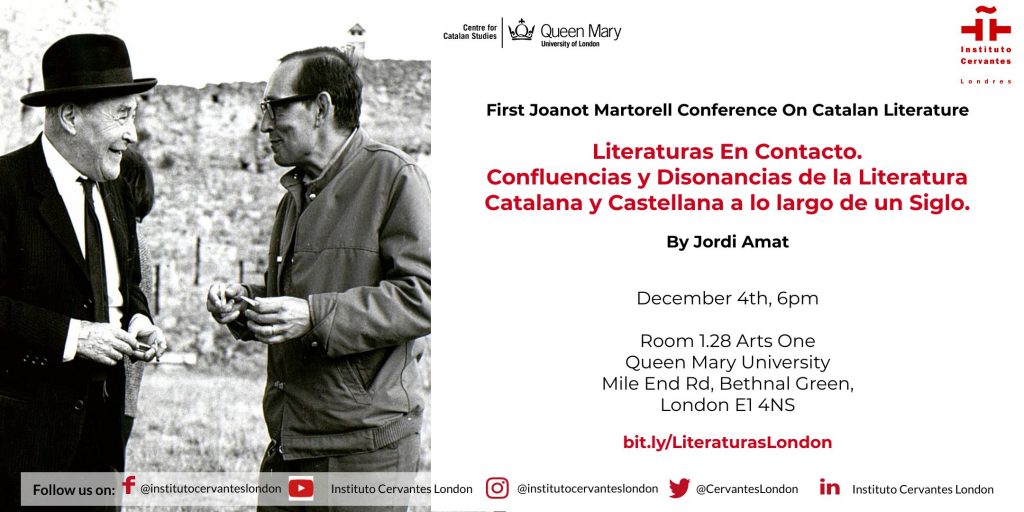
El Instituto Cervantes de Londres inaugura hoy, con una charla del ensayista Jordi Amat, las Conferencias Joanot Martorell. El director de la sede londinense, Ignacio Peyró, cuenta las razones de esta iniciativa: “En nuestra programación cultural la huella catalana es muy importante: en estos últimos tiempos hemos trabajado con Benet Casablancas, Maria Canyigueral, Adolf Pla, Irene Solà, el traductor Peter Bush…” Mañana mismo, Eduardo Mendoza charlará con Peyró de su obra, pero el director va un poco más allá: “Quería solemnizar de algún modo esta presencia con un ciclo con vocación de continuidad. De aquí nació esta primera conferencia sobre literatura catalana, que tendrá carácter anual”.
Peyró relata que negoció el nombre con el profesor John London, que es el director del Centre Català de la Universidad Queen Mary, porque “en el Tirant hay una gran conexión inglesa y, además, es también un libro muy cervantino”. El director de la sede londinense añade: “Por vocación nos gusta trabajar con departamentos universitarios, y el Centre Català de la Universidad Queen Mary (oficialmente, Centre for Catalan Studies) es un departamento muy prestigioso y tenemos muy buena relación”.
Peyró considera que es un momento dulce para la literatura catalana, porque “en el Reino Unido se está traduciendo más que nunca del catalán, y para muchos lectores este repunte del interés editorial significa entrar en contacto por primera vez con nombres para nosotros bien conocidos. De Permafrost de Eva Baltasar a obras de Sales, Rodoreda, Margarit o Pla, o antologías poéticas, creo que el momento es oportuno para una iniciativa de este tipo”.
El director reconoce “una inclinación muy propia” por estos autores. “En estos últimos años he podido hablar sobre Pla y el mundo británico en las universidades de Oxford y Leeds… Sea como fuere, queda mucho por hacer, queda mucho por traducir, para que se conozcan autores, como Perucho, Gimferrer…”, pone como ejemplo.
“El Cervantes es la casa de Garcilaso y de Ausiàs Marc, de todas las lenguas que se hablan en España, y es bueno que se conozca y se haga visible”, concluye Peyró.
Sobre la conferencia de Jordi Amat, Confluencias y disonancias de la literatura catalana y castellana a lo largo de un siglo, el ensayista cuenta: “Me parece útil desde un punto de vista de historia cultural explicar que cuando en Catalunya se configura el sistema literario moderno –en el sentido que Bourdieu lo razonó a Las reglas del arte– se hace en catalán después de los siglos dominados por la diglosia. Ese sistema, con autores, editoriales y revistas, da un paso adelante con la institucionalización noucentista, que tiene el afán de edificar una cultura plenamente autónoma. Es este sistema el que el franquismo destruirá, para intentar acabar con la identidad nacional, pero el proceso de sustitución no acabará siendo aquel que planificaba el modelo cultural del régimen, sino que aparecerá uno en castellano que es crítico con la dictadura”.
“Tradicionalmente cuando se pretendía poner en valor las relaciones literarias de catalanes y castellanos, se elegía como patrón a Boscán, el amigo de Garcilaso que cambia de lengua. Apostar por Martorell implica un cambio de paradigma simbólico que vale la pena poner en valor”, considera Amat.
“La casa de los espíritus is a cry for freedom, human rights and the history of women”
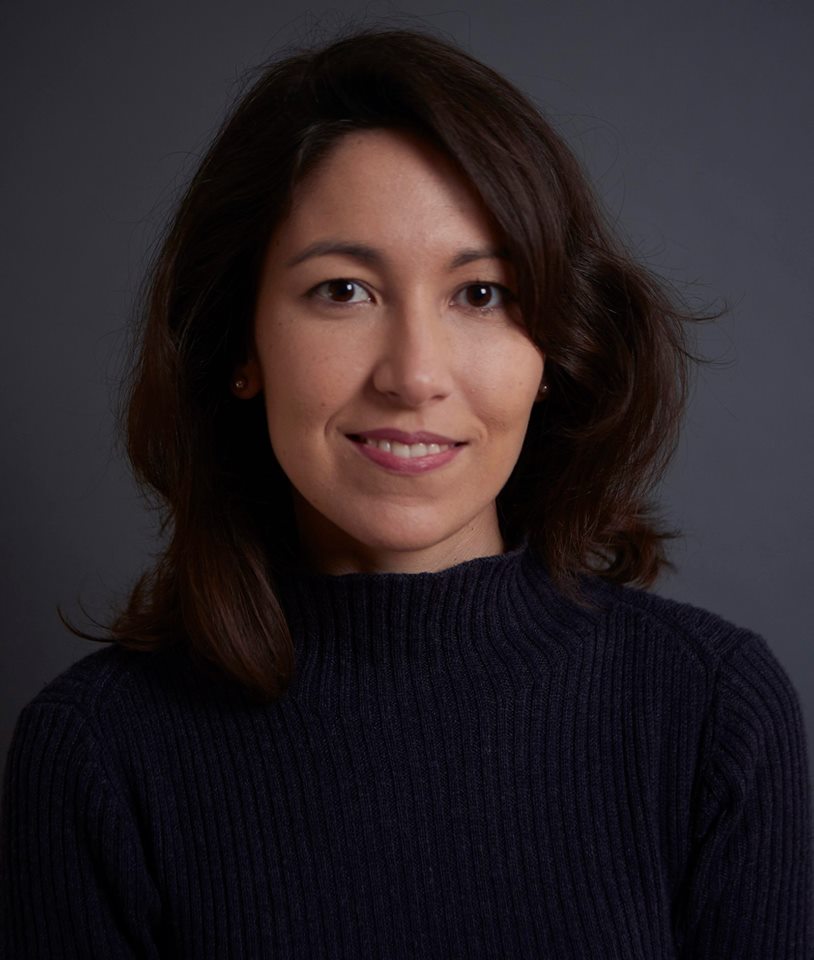
We chat with Paula Paz, associate director at Cervantes Theatre, who is currently directing La casa de los espíritus, a novel by Isabel Allende adapted for theatre in both Spanish and English by Caridad Svich.
Performances of the play in London continue until December 11th.
Why La casa de los espíritus?
We wanted to choose La casa de los espíritus this year because we wanted to dedicate it to all the creative women everywhere. Now, as we come to the end of the year, it has become our biggest production of 2019. In previous years, we showcased Bodas de Sangre, La Casa de Bernarda Alba and Yerma by Lorca. But this year, we wanted to choose an author of renown with a work that many people would know and love which would attract enough attention to catch a Spanish and Latin American audience.
When contacted Isabel Allende, we already knew of the adaptation for the theatre translated by the American playwright Caridad Svich. Svich, who speaks both Spanish and English, also has ancestry from several Latin American countries and wrote the adaptation of La casa de los espíritus several years ago. It has been performed in several theatres across the United States and Mexico but never in the United Kingdom or Spain.
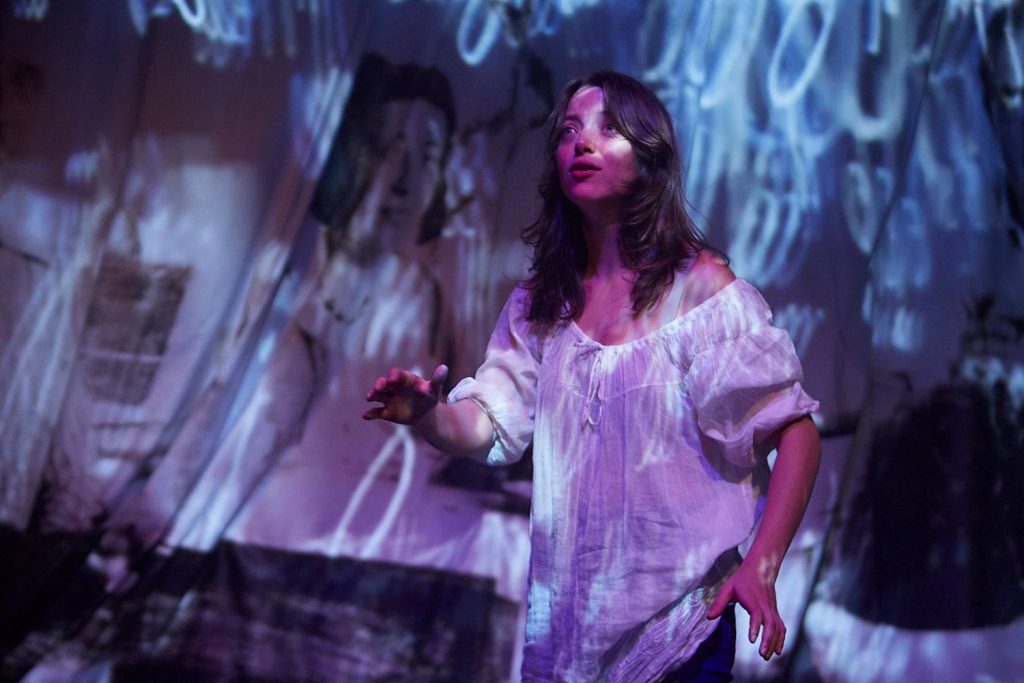
Allende transferred the rights and gave us the permission to perform it here. Initially there were difficulties due to the current recording of the television adaptation of La casa de los espíritus but thankfully, Allende intervened in the process to help us stage it here. And that’s how we embarked on this adventure with a grand total of 12 actors in the cast. It is the greatest work we have ever undertaken at the Cervantes Theatre. Not only of the size of the team, but also of the epic scale of this work which mixes four generations, the history of an entire family as well as a country whilst also crossing between time, spirits, etc. It is a wonderful work but it is also very complex at the same time. It requires a full set of scenery, lighting and sound which work together to create an inclusive atmosphere so that this story can become universal; about all families in all countries around the world. Although the novel never tells us the location of the Trueba family home, my guess is that it could be any country in Latin America, or indeed: any country in the world. This story resonates with everyone.
While directing La casa de los espíritus, I saw how history repeats itself through the narrative. I also found it very beautiful to see the importance of words on an individual, social and global level. The written word enables personal experience to transcend history and gives it the possibility to serve others so as not to not repeat the same mistakes from the past.
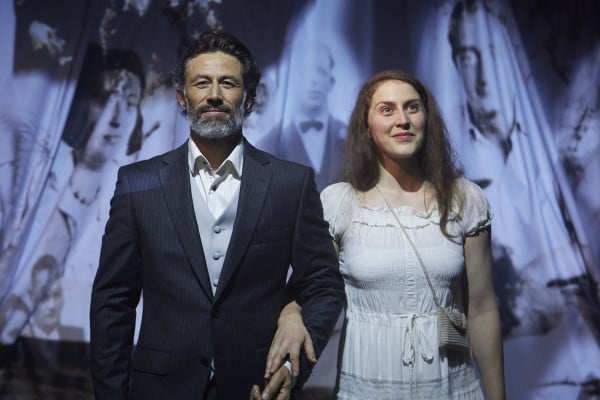
What is it like to work with a team of 12 actors?
We have a multilingual cast for both the Spanish and English performances of the play which is rare because we usually have two different casts or a mix. In this case, we did it to maintain the essence of the story which has firm roots in Latin America. We therefore wanted the English translation to resemble the language of Latin America.
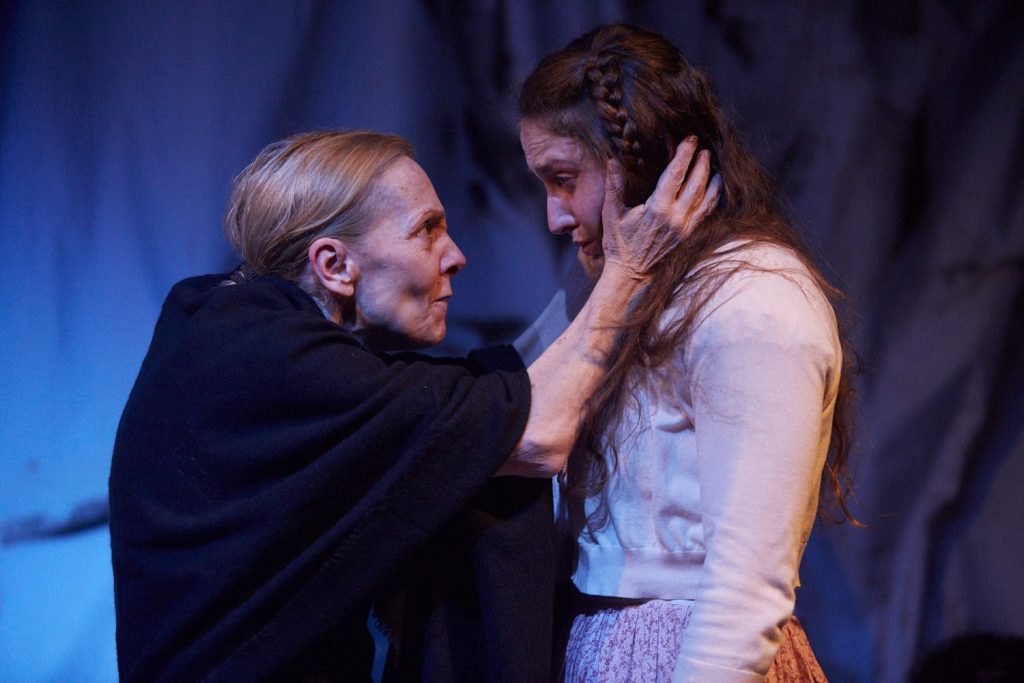
Why would you advise that the students of the Instituto Cervantes should come to see the work?
I recommend that they read the novel before they come because it is wonderful and everyone should read it. Secondly, it will inform their viewing of the play and make them more aware of the linguistic elements. It is a cry for freedom, for human rights and for awareness of the contribution that women have made to history. Depending on the level of Spanish that students have, they could come and see it in English first and then in Spanish, so they learn well about the story and the characters and then they appreciate the nuances in Spanish.
“La casa de los espíritus es un grito a la libertad, a los derechos humanos y a la historia de las mujeres”
Charlamos con Paula Paz, directora asociada del Cervantes Theatre y directora del montaje de la obra que, basada en la novela La casa de los espíritus de Isabel Allende y traducida por Caridad Svich, se representa en Londres hasta el próximo 11 de diciembre.

¿Por qué La casa de los espíritus?
Quisimos elegir La casa de los espíritus para este año, que está dedicado a las mujeres creadoras. Ahora, a finales de año, que hacemos la producción más grande del año, los primeros años hicimos a Lorca, con Bodas de sangre, La casa de Bernarda Alba y Yerma. Este año, quisimos elegir a una autora de esa envergadura con una obra que conociera mucha gente y que pudiera llamar la atención y atraer a un público tanto español como latinoamericano. Contactamos con Isabel Allende, nosotros conocíamos la adaptación de la dramaturga norteamericana Caridad Svich, quien tiene ascendencia de varios países latinoamericanos, con lo cual ella habla español y habla inglés. Ella había hecho la adaptación de La casa de los espíritus hace ya varios años y se había presentado en varios teatros de Estados Unidos y México, pero nunca en Reino Unido y nunca en España.

Isabel Allende nos dio los derechos, y estuvo difícil porque van a hacer una serie de televisión de La casa de los espíritus, y estaban comprometidos, pero Isabel intervino para poder hacerlo. Y así fue como nos embarcamos en esta aventura, con 12 actores en el reparto. Es la obra más grande que hemos hecho en el Cervantes Theatre hasta el momento. No solo de envergadura del equipo, sino también de lo épico de esta obra, que mezcla cuatro generaciones, la historia de una familia entera, de un país y cruce entre tiempo, los espíritus, etc. Es una obra maravillosa pero muy compleja a la vez. Requiere de un arrope de escenografía, de iluminación y de sonido para que pueda llegar esta historia de una familia de un país, y del mundo, que se puede extrapolar.
Aunque en la novela no se dice dónde está la familia Trueba, pero sí que puede ser cualquier país en Latinoamérica y cualquier país del mundo.
Además, se ve cómo la historia se va repitiendo, y también me parece muy bonito, dirigiendo La casa de los espíritus, que he tratado de que se mantuviese, junto con la importancia de la palabra, a nivel individual, social y global de la historia de un país, como la historia que se escribe y trasciende tiene una influencia para que sirva a los demás y no se vuelvan a repetir los errores del pasado.

¿Cómo es trabajar con el equipo de 12 actores?
Es el mismo reparto para la obra tanto en español como en inglés, si bien normalmente hacemos dos repartos diferentes o una mezcla. En este caso, para mantener la esencia de esta historia, que pertenece a Latinoamérica, hemos querido que en inglés también tenga un aire de Latinoamérica.

¿Qué aconsejas a los alumnos del Instituto Cervantes que vengan a ver la obra?
Yo recomiendo que si pueden lean la novela porque es maravillosa y que todo el mundo tiene que leer. Es un grito a la libertad, a los derechos humanos y a la historia de las mujeres y como la ayuda entre ellas hace que avance el mundo. Y dependiendo del nivel de español que tengan, que vengan a verla en inglés primero y luego en español para enterarse bien de la historia y de los personajes y luego ir apreciando los matices en español.
Instituto Cervantes Secretary General signs an agreement with the Chamber of Commerce to promote Spanish in the United Kingdom
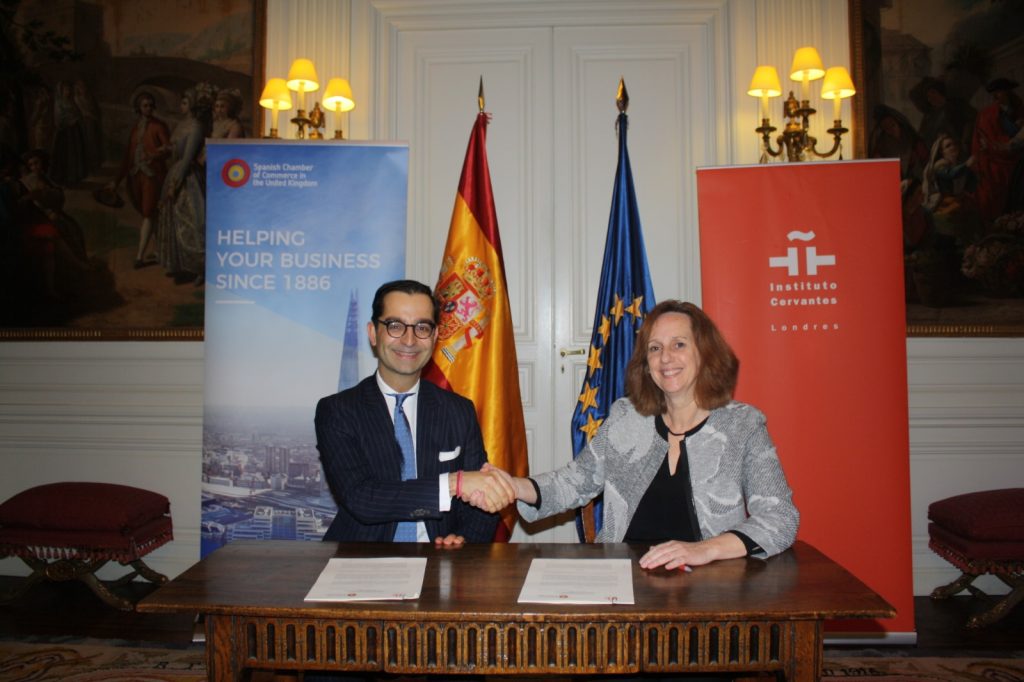
This morning, Carmen Noguero, Secretary General of the Spanish cultural institution, signed two documents: the first cooperation protocol between Instituto Cervantes and the British Council and also an agreement with the Spanish Chamber of Commerce in the United Kingdom for the promotion of Spanish language and culture. Likewise, Noguero has presented the Spanish in the World 2019 Yearbook to Spanish-American ambassadors, diplomats and academics, at one event, and to Spanish teachers, Hispanic and cultural managers at another event.
Tomorrow, Noguero will head to Oxford University where she will conclude her trip accompanied by the director of International Relations at Instituto Cervantes, Rafael Soriano; the director of Institute Cervantes in London, Ignacio Peyró; and the director for Manchester and Leeds, Francisco Oda.
Yearbook presentations to diplomats and Hispanists
Noguero visited Instituto Cervantes in London, where she held a meeting with the staff of the three Cervantes institutions in the United Kingdom: London, Manchester and Leeds. She was shown the library and the centre’s historical archive, which are well-known for their collection of travel books in Spain and documentation of the Civil War.
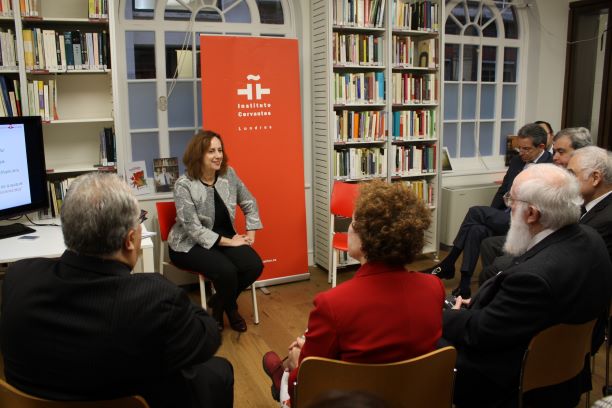
Her first public event was the presentation of the largest academic publication by Instituto Cervantes, the 2019 edition of The Spanish in the world yearbook. Previously, a large delegation of Latin American diplomats and academics.
The ambassadors of Honduras, Guatemala, Nicaragua, Paraguay, Ecuador, Panama, Peru and El Salvador were at the event, in addition to Cristina Cortés, director of Canning House, the prestigious think tank on Latin American affairs; and the director of the office of the Universidad Autónoma de México in London, Ana Elena González, among others. The different offices of Instituto Cervantes cooperate in cultural matters continuously with the Embassies and cultural councils of the Latin American countries.
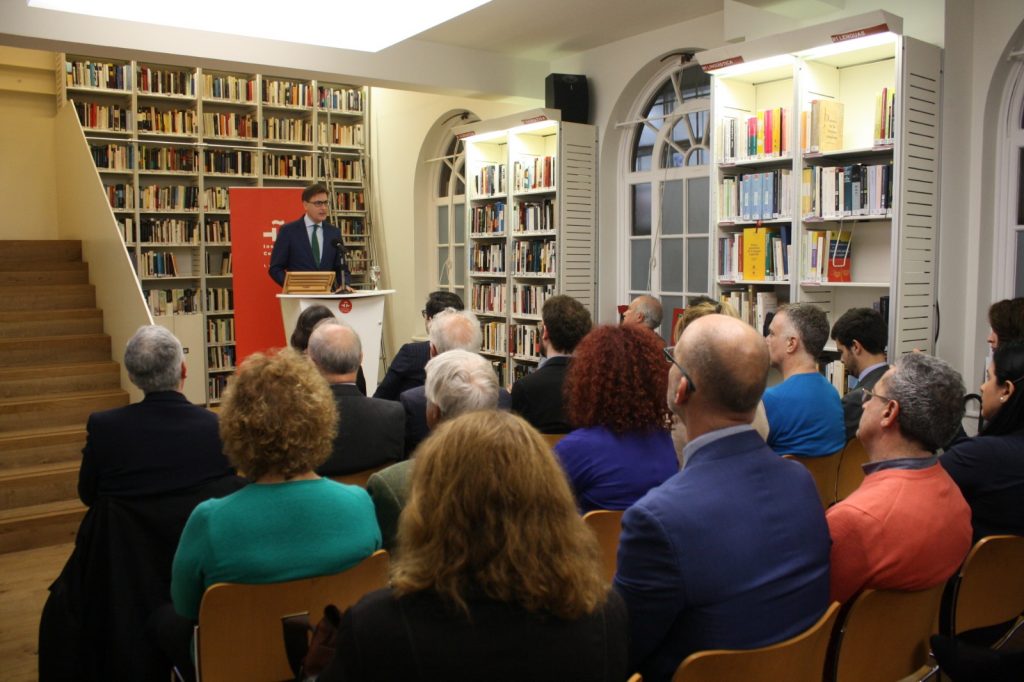
The Secretary General also presented the yearbook at another event for Spanish teachers in the United Kingdom, Hispanists and cultural managers. Among the attendees were guests and professors such as Sir Barry Ife, Trevor Dadson, Catherine Davies or Sebastian Balfour, and the president of the association of Spanish teachers in the United Kingdom (ELE-UK), Vicens Colomer.
Spanish in the world 2019 gathers current data and in-depth analysis on the presence and importance of the Spanish language globally. In this edition, the volume highlights significant figures such as the 580 million people who speak Spanish in the world (7.6% of the world’s population). Of these, 483 million are native speakers which makes Spanish the second mother tongue in the world by number of speakers. In addition, about 22 million people in 110 countries study it as a foreign language. Spanish is also the third most used language on the internet, and the report corresponding to 2019 reflects, as a novel fact, its growth in Linkedin.
Agreement signature with the Spanish Chamber of Commerce
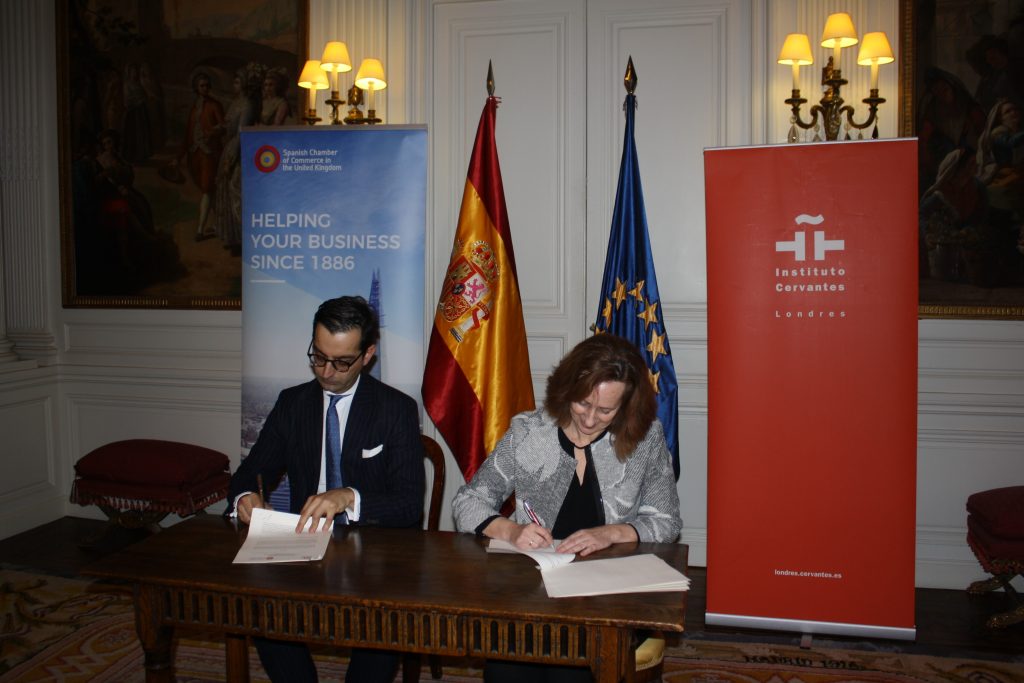
Together with the protocol signed with the British Council, the agreement signed with the Spanish Chamber of Commerce in the United Kingdom is one of the strengths of the trip. The event took place at the residence of the ambassador of Spain in London, Carlos Bastarreche, and was signed by the Chamber’s president, lawyer and solicitor Eduardo Barrachina. Barrachina stressed the importance of the agreement as a “model of public collaboration- private service to the projection of Spanish culture”.
“The Chamber and its companies understand very well that Spanish and Spanish culture are a source of wealth. This framework of collaboration guarantees that the Spanish culture has greater projection in the United Kingdom, and with this signature, the Chamber and its companies recognize the economic value of the Spanish culture,” said Barrachina.
In the agreement, the first signed by both institutions, various actions to promote the Spanish language and culture are contemplated, especially in the field of Spanish for business. The Chamber brings together more than three hundred Spanish companies operating in the United Kingdom.
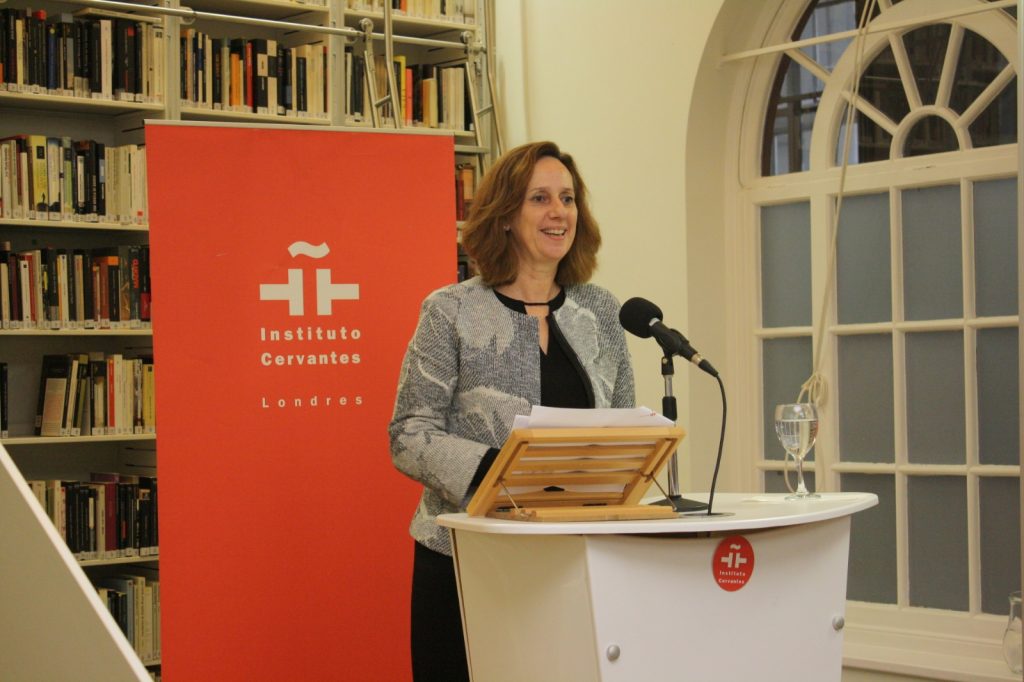
Meeting with Spanish executives of the City
At the end of the afternoon, Noguero attended the Christmas reception of the British Spanish Society, a charity founded in 1916 that promotes friendship and understanding between British and Spanish people. Noguero’s journey culminated with a dinner, offered by Hispania restaurant, with representatives of the Chamber of Commerce and the Spanish business and financial world in the City of London.
Visit to Sir John Elliott and hispanism authorities in Oxford
Tomorrow, Noguero, at the culmination of her trip, will meet with the great Hispanic and Prince of Asturias Award for Social Sciences Sir John Elliott in the city of Oxford. Likewise, she will hold meetings at Exeter College with the greatest academic authorities in Hispanicism and teaching of the language of the famous university, specifically, professor “Alfonso XIII” of Spanish Studies, Jonathan Thacker, and professor and coordinator of Spanish in the Faculty of Medieval and Modern Languages, Javier Muñoz-Basols. Finally, the General Secretary will attend a lunch at Magdalen College, offered in her honor by professor of Spanish literature Juan Carlos Conde, promoter of the Madariaga Cycle of conferences on Spanish issues, with which the Instituto Cervantes collaborates.
La Secretaria General del Cervantes firma un acuerdo con la Cámara de Comercio para impulsar el español en Reino Unido

Tras la firma esta mañana del primer protocolo de cooperación entre el Instituto Cervantes y el British Council, la Secretaria General de la institución cultural española, Carmen Noguero, suscribió un acuerdo con la Cámara de Comercio de España en Reino Unido para el fomento de la lengua y cultura españolas. Asimismo, la ‘número dos’ del Cervantes presentó el anuario El español en el mundo 2019 ante embajadores, diplomáticos y académicos hispanoamericanos, por una parte, y ante profesores de español, hispanistas y gestores culturales, por otra.
La Secretaria General del Instituto Cervantes se trasladará mañana a la Universidad de Oxford, donde pondrá punto final a un viaje en el que le acompañan el director de Relaciones Internacionales del Instituto Cervantes, Rafael Soriano; el director del centro de Londres, Ignacio Peyró; y el director de los centros de Mánchester y Leeds, Francisco Oda.
Presentaciones del Anuario ante diplomáticos e hispanistas

Noguero visitó el Instituto Cervantes en Londres, donde mantuvo una reunión con el personal de los centros de la institución en Reino Unido (Londres, Mánchester y Leeds), y conoció de primera mano la biblioteca y el archivo históricos del centro, notables, respectivamente, por su colección de libros de viajes por España y su documentación de la Guerra Civil.
Su primer acto público fue la presentación de la mayor publicación académica del Instituto Cervantes, el anuario El español en el mundo, en su edición de 2019, ante una nutrida delegación de diplomáticos y académicos hispanoamericanos. En el público estuvieron presentes los embajador de Honduras, Guatemala, Nicaragua, Paraguay, Ecuador, Panamá, Perú y El Salvador, además de Cristina Cortés, directora del think-tank de referencia en asuntos iberoamericanos, Canning House; y la directora de la oficina de la Universidad Autónoma de México en Londres, Ana Elena González, entre otras personalidades. Las distintas sedes del Instituto Cervantes cooperan en materia cultural de modo continuado con las Embajadas y consejerías culturales de los países hispanoamericanos.

La Secretaria General también presentó su anuario en otro acto destinado a profesores de español en Reino Unido, hispanistas y gestores culturales. Entre los asistentes se pueden mencionar a profesores como Sir Barry Ife, Trevor Dadson, Catherine Davies o Sebastian Balfour, o el presidente de la asociación de docentes de español en Reino Unido (ELE-UK), Vicens Colomer.
El español en el mundo 2019 reúne datos actualizados y análisis en profundidad sobre la presencia e importancia de la lengua española a nivel global. En esta edición, el volumen destaca cifras significativas como los 580 millones de personas que hablan español en el mundo (el 7,6% de la población mundial). De ellas, 483 millones son hablantes nativos, lo que convierte al español en la segunda lengua materna del mundo por número de hablantes. Además, cerca de 22 millones de personas en 110 países lo estudian como lengua extranjera. El español es asimismo la tercera lengua más utilizada en internet, y el informe correspondiente a 2019 refleja, como dato novedoso, su crecimiento en Linkedin.
Firma de un acuerdo con la Cámara de Comercio española

Junto al protocolo firmado con el British Council, el acuerdo suscrito con la Cámara Oficial de Comercio de España en el Reino Unido es uno de los puntos fuertes del viaje. El acto tuvo lugar en la residencia del embajador de España en Londres, Carlos Bastarreche, y contó como signatario por parte de la Cámara con su presidente, el abogado y solicitor Eduardo Barrachina, quien subrayó la importancia del acuerdo como “modelo de colaboración público-privada al servicio de la proyección de la cultura española”.
“La Cámara y sus empresas entienden muy bien que el español y la cultura española son fuente de riqueza. Este marco de colaboración garantiza que la cultura española tenga mayor proyección en el Reino Unido, y con esta firma, la Cámara y sus empresas reconocen el valor económico de la cultura española”, afirmó Barrachina.
En el acuerdo, el primero que firman ambas instituciones, se contemplan diversas acciones de promoción de la lengua y cultura españolas, en especial en el ámbito del español para los negocios. La Cámara aglutina a más de trescientas empresas españolas que operan en Reino Unido.

Encuentro con ejecutivos españoles de la City
Al terminar la tarde, Carmen Noguero asistió a la recepción de Navidad de la British Spanish Society, una organización benéfica fundada en 1916 y que promueve la amistad y el entendimiento entre británicos y españoles. Su día culminó con una cena, ofrecida por el restaurante Hispania, con representantes de la Cámara de Comercio y del mundo empresarial y financiero español en la City de Londres.
Visita a Sir John Elliott y a autoridades del hispanismo en Oxford
Mañana, la Secretaria General del Cervantes, como culminación de su viaje, se entrevistará con el gran hispanista y premio Príncipe de Asturias de Ciencias Sociales Sir John Elliott, en la ciudad de Oxford. Asimismo, mantendrá reuniones en Exeter College con las mayores autoridades académicas en hispanismo y docencia de la lengua de la célebre universidad, en concreto, el catedrático “Alfonso XIII” de Estudios Españoles, Jonathan Thacker, y el profesor titular y coordinador de español en la Facultad de Lenguas Medievales y Modernas, Javier Muñoz-Basols. Por último, Carmen Noguero asistirá en Magdalen College a un almuerzo ofrecido en su honor por el catedrático de literatura española Juan Carlos Conde, impulsor del Ciclo Madariaga de conferencias sobre temas españoles, con el que colabora el Instituto Cervantes.
For the first time, Instituto Cervantes and the British Council sign an agreement to promote «joint work» in London
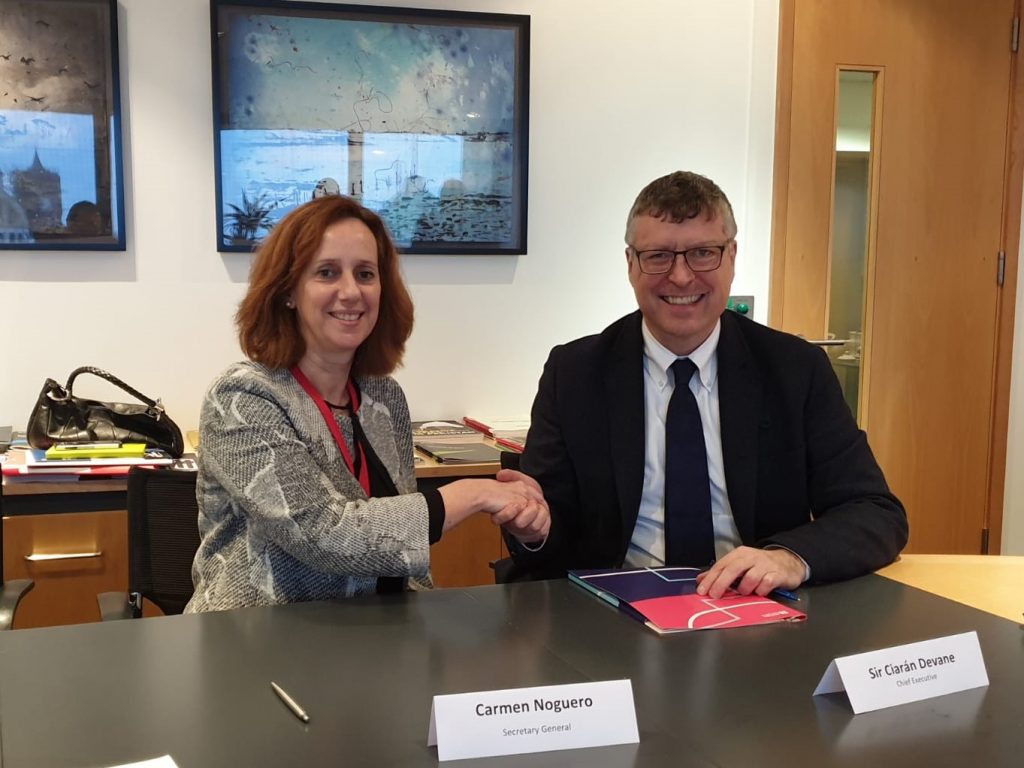
The secretary general of Instituto Cervantes, Carmen Noguero, and the executive director of the British Council, Sir Ciarán Devane, signed a collaboration agreement in London today – the first one signed by both parties- with the aim of strengthening the bilateral dialogue and promoting «the joint work »so that each institution can« achieve its strategic results more effectively».
The agreement includes the future participation of Instituto Cervantes and the British Council in joint projects and exchange programs, as well as a possible coordination of their respective strategic plans.
In this first official meeting, held at the headquarters of the British organisation in London, Noguero was accompanied by the director of International Relations at Instituto Cervantes, Rafael Soriano, and the directors of Instituto Cervantes in London, Ignacio Peyró, and of Manchester and Leeds, Francisco Oda.
Sir Ciarán Devane also attended on behalf of the British Council, as well as Siobhan Foster-Perkins who is the regional director for the European Union, the rest of Europe and the Americas; the regional director for the European Union, Andy Mackay, and the director of Spain, Mark Howard.

Strengthening European cooperation
The signing of this unprecedented memorandum of understanding between both institutions aims to give continuity and reinforce the fruitful dialogue between Spain and the United Kingdom. It will build on the conversations held over the last year in the field of cultural diplomacy, and the joint exploration of new approaches to work on the agendas.
At the meeting held in London today, each party gave a presentation of its organisation and external network, as well as an introduction to its strategic plan. Afterwards, they analysed the current status of foreign languages and their learning in both Spain and the United Kingdom.
In this regard, both delegations underlined the characteristics of both Spanish and English languages as constantly growing international communication languages, «complementary and not competing with each other.» They also agreed to claim the teaching and learning of languages as part of the response to the challenges of globalisation.
At the end of the meeting and the signing of the agreement, Carmen Noguero expressed her satisfaction for “sharing agendas in areas of joint interest and sharing resources and experiences”. For his part, Sir Ciarán Devane said that the collaboration between both parties «will contribute to improving links between our organisations and creating new cultural and educational connections between people around the world.»
El Instituto Cervantes y el British Council firman por primera vez en Londres un acuerdo para impulsar «el trabajo conjunto»
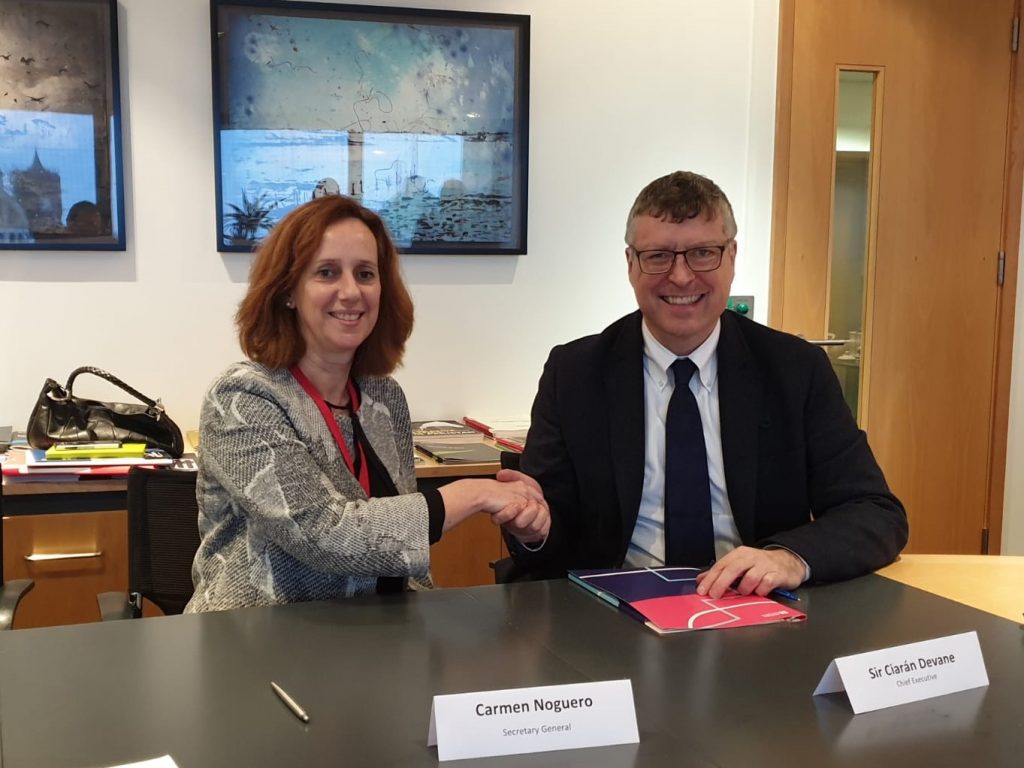
La secretaria general del Instituto Cervantes, Carmen Noguero, y el director ejecutivo del British Council, Sir Ciarán Devane, firmaron hoy en Londres un acuerdo de colaboración –el primero que suscriben ambas entidades– con el objetivo de reforzar el diálogo bilateral e impulsar «el trabajo conjunto» para que cada institución pueda «lograr sus resultados estratégicos de manera más efectiva».
El acuerdo incluye la eventual participación del Instituto Cervantes y del British Council en proyectos conjuntos o en programas de intercambios, así como una posible coordinación de los planes estratégicos respectivos.
En esta primera reunión oficial, celebrada en la sede del organismo británico, acompañaron a Carmen Noguero, por parte del Instituto Cervantes, el director de Relaciones Internacionales, Rafael Soriano, y los directores de los centros de Londres, Ignacio Peyró, y de Mánchester-Leeds, Francisco Oda.
Por parte del British Council asistieron, además de Sir Ciarán Devane, la directora regional para Unión Europea, resto de Europa y las Américas, Siobhan Foster-Perkins; el director regional para la Unión Europea, Andy Mackay, y el director de España, Mark Howard.

Reforzando la cooperación europea
La firma de este primer memorándum de entendimiento tiene como objeto dar continuidad y reforzar la fructífera interlocución que España y el Reino Unido han mantenido en el último año en el ámbito de la diplomacia cultural, y la exploración conjunta de nuevos enfoques para trabajar en las agendas europeas.
En la reunión mantenida hoy en Londres, cada una de las partes hizo una presentación de su organización y red exterior, así como una introducción a su plan estratégico. A continuación, analizaron la situación de las lenguas extranjeras y su aprendizaje tanto en España como en Reino Unido.
A este respecto, ambas delegaciones subrayaron el carácter del español y el inglés como lenguas de comunicación internacional en constante crecimiento, «complementarias y no competidoras entre sí». Coincidieron además en reivindicar la enseñanza y el aprendizaje de idiomas como parte de la respuesta a los desafíos de la globalización.
Al término de la reunión y la firma del acuerdo, Carmen Noguero manifestó su satisfacción por «compartir agendas en áreas de interés conjunto y poner en común recursos y experiencias». Por su parte, Sir Ciarán Devane declaró que la colaboración entre ambas partes «contribuirá a mejorar los vínculos entre nuestras organizaciones y a crear nuevas conexiones culturales y educativas entre personas de todo el mundo».


